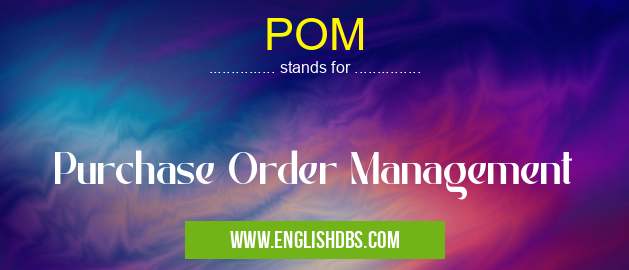What does POM mean in GENERAL
Purchase Order Management (POM) is a process used by businesses to manage and track purchase orders for goods or services. POM is an important part of the supply chain management process as well as customer service. It involves tracking every step of the transaction, including when it was placed, who it was sent to, when it was received, and when any payment or delivery occurs. Purchase orders are also used to track expenses so that businesses can better understand their costs and stay on budget. Although purchase order management is typically handled manually by businesses, some companies are increasingly turning to digital systems to facilitate the process.

POM meaning in General in Business
POM mostly used in an acronym General in Category Business that means Purchase Order Management
Shorthand: POM,
Full Form: Purchase Order Management
For more information of "Purchase Order Management", see the section below.
Benefits Of POM
Using a POM system has several advantages over traditional manual processes. Firstly, digital purchase order management improves accuracy by automating mundane tasks such as data entry which reduces errors and streamlines processes such as invoice reconciliation and data retrieval from reports or documents. Additionally, digital systems help in anticipating inventory needs since they enable real-time tracking and monitoring of suppliers’ deliveries and allow access anytime-anywhere with cloud-based solutions that store all purchase records in one place. Furthermore having a unified system helps companies maintain tighter control over their suppliers’ performance along with closer supplier relationships through enhanced collaboration abilities like two-way communication channels between buyers and suppliers, resulting in reduced costs due to efficient operations such as timely approvals and streamlined payments.
Essential Questions and Answers on Purchase Order Management in "BUSINESS»GENERALBUS"
What is Purchase Order Management?
Purchase Order Management (POM) is the process of simplifying and streamlining the ordering, tracking and fulfillment of goods or services. It helps to ensure accurate ordering of items, prompt payment and delivery of goods to customers.
How does POM help improve efficiency?
POM automates many manual tasks that are often associated with procurement processes. By reducing the amount of time spent on administrative tasks, organizations can reduce costs, improve accuracy and increase efficiency.
How does POM ensure accurate ordering of items?
POM provides an easy-to-use system for entering purchase orders that ensures accuracy based on criteria such as product details, quantity requirements, delivery dates, supplier selection and more. This helps to reduce mistakes in ordering and fulfilment.
What are some of the benefits of using POM?
Some benefits include increased visibility into supply chain operations throughout an organization; improved responsiveness to customer needs; stronger supplier relationships; greater control over inventory and costs; ease of compliance with financial regulations; improved security measures; and better overall performance in procurement processes.
What type of data does POM track?
The information tracked by POM varies depending on the implementation but it typically includes order request details, pricing information from suppliers, product availability from vendors, shipment tracking information from carriers and invoices from providers.
Does POM provide insights about spending habits?
Yes! With a comprehensive view into spending across the organization, POM can be used to gain insight into budgeting patterns such as periods with higher levels of expenditure or areas where savings could be made. This allows for better alignment between spend and business objectives when making purchasing decisions.
Is training required for using a purchase order management system?
Generally speaking, no specific training is required though users may wish to understand core concepts related to procurement principles as well as how to use any particular system functionalities in order to maximize its value within their organization.
Final Words:
In conclusion, Purchase Order Management (POM) is an essential part of any business’ supply chain process that enables them to effectively monitor their orders from start to finish which leads to more efficient operations resulting in cost savings in addition to improved customer satisfaction levels via accurate reporting capabilities enabled through digital purchase order systems. Investing in a good Purchase Order Management System could greatly benefit your company if you are looking for ways to maximize efficiency within your operations while minimizing costs.
POM also stands for: |
|
| All stands for POM |
